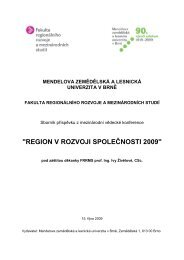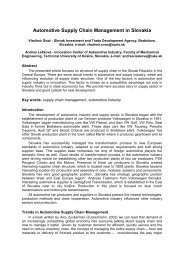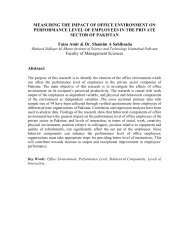performance evaluation in the hospitality industry - Icabr.com
performance evaluation in the hospitality industry - Icabr.com
performance evaluation in the hospitality industry - Icabr.com
Create successful ePaper yourself
Turn your PDF publications into a flip-book with our unique Google optimized e-Paper software.
However, <strong>in</strong> a fast mov<strong>in</strong>g and dynamic bus<strong>in</strong>ess environment, can it truly be stated that <strong>the</strong><br />
four chosen Dimensions and, <strong>in</strong>deed, <strong>the</strong> Objectives with<strong>in</strong> each of <strong>the</strong> four Dimensions, to<br />
be truly equally important or „balanced‟, that is, with no <strong>in</strong>dication of prioritisation? Implicitly,<br />
an element of rationalisation, if not quite sequential prioritisation, would have taken place a<br />
priori s<strong>in</strong>ce <strong>the</strong> choice of <strong>the</strong> four Dimensions implies that o<strong>the</strong>r possible alternatives may<br />
have been left out. Also, <strong>the</strong> choice of <strong>the</strong> f<strong>in</strong>ite number of Objectives is a determ<strong>in</strong>ed choice<br />
amongst a long list of potential Objectives.<br />
Mov<strong>in</strong>g ahead towards “Un-Balanc<strong>in</strong>g” <strong>the</strong> Scorecard by means of a process of<br />
rationalisation and prioritisation by <strong>the</strong> various stakeholders <strong>in</strong>volved <strong>in</strong> both supply and<br />
demand sides of <strong>the</strong> Hospitality <strong>in</strong>dustry, that will eventually lead us to <strong>the</strong> design and<br />
development of a Prioritised Score Card (PSC).<br />
7. THE ANALYTIC HIERARCHY PROCESS (AHP)<br />
In <strong>com</strong>es <strong>the</strong> Analytic Hierarchy Process (AHP), “a framework of logic and problem-solv<strong>in</strong>g<br />
that spans <strong>the</strong> spectrum from <strong>in</strong>stant awareness to fully <strong>in</strong>tegrated consciousness, by<br />
organiz<strong>in</strong>g perceptions, feel<strong>in</strong>gs, judgements and memories <strong>in</strong>to a hierarchy of forces that<br />
<strong>in</strong>fluence results” (Saaty, 1980). The AHP <strong>the</strong>refore is a system by which people, th<strong>in</strong>gs,<br />
ideas, objectives/KRAs and so forth are put <strong>in</strong> a hierarchy or rank<strong>in</strong>g system with an<br />
<strong>in</strong>dication of prioritisation.<br />
“To make a decision”, such as, which Dimensions/Objectives to <strong>in</strong>clude or exclude and <strong>in</strong><br />
which hierarchy order, “one needs various k<strong>in</strong>ds of knowledge, <strong>in</strong>formation and technical<br />
data. These concern<br />
details about <strong>the</strong> problem to be decided,<br />
<strong>the</strong> people or actors <strong>in</strong>volved,<br />
<strong>the</strong>ir objectives and policies,<br />
<strong>the</strong> <strong>in</strong>fluences affect<strong>in</strong>g <strong>the</strong> out<strong>com</strong>es, and<br />
<strong>the</strong> time horizons, scenarios and constra<strong>in</strong>ts“ (Saaty, 1994)<br />
It seems to follow that <strong>in</strong> present<strong>in</strong>g <strong>the</strong> constituent parts of a BSC, all<br />
Dimensions/Objectives that are ultimately presented and acted upon are important but some<br />
are more important than o<strong>the</strong>rs at some po<strong>in</strong>t <strong>in</strong> time to different Stakeholders. Dur<strong>in</strong>g a<br />
period of extreme “credit crunch”, manag<strong>in</strong>g Collection Period hence Cash Flow may rank as<br />
a higher priority than even all o<strong>the</strong>r f<strong>in</strong>ancial objectives put toge<strong>the</strong>r, <strong>in</strong>clud<strong>in</strong>g Profit. In a<br />
time of economic recession, <strong>in</strong>creas<strong>in</strong>g Repeat Bus<strong>in</strong>ess and improv<strong>in</strong>g Customer<br />
Satisfaction may rank higher <strong>in</strong> importance than <strong>in</strong>creas<strong>in</strong>g Market Share.<br />
The general pr<strong>in</strong>ciple of <strong>the</strong> AHP methodology <strong>in</strong>volves <strong>the</strong> pair-wise <strong>com</strong>parison of various<br />
alternatives of which <strong>the</strong> best decision is to be chosen (Render and Stair Jr. 2005). The<br />
decision-maker(s) beg<strong>in</strong> by lay<strong>in</strong>g out <strong>the</strong> overall hierarchy of <strong>the</strong> decision. At <strong>the</strong> highest<br />
level, or Level-1 <strong>in</strong> this context, we can place <strong>the</strong> Economic and Market Conditions<br />
prevail<strong>in</strong>g, or assumed/forecasted <strong>in</strong> a Sensitivity Analysis context. Thereafter we allow for<br />
vary<strong>in</strong>g Stakeholder Objectives/Strategies at a Level-2. The BSC addresses a „need‟ – <strong>the</strong><br />
need to measure and manage <strong>the</strong> key drivers of Stakeholder value, a large number of which<br />
may <strong>in</strong>deed be <strong>in</strong>tangible assets and values. In our model we can th<strong>in</strong>k of <strong>the</strong>se „assets‟ <strong>in</strong><br />
Level-3 as be<strong>in</strong>g <strong>the</strong> orig<strong>in</strong>al four Dimensions of <strong>the</strong> BSC, i.e., <strong>the</strong> Customer, <strong>the</strong> Employee,<br />
8









